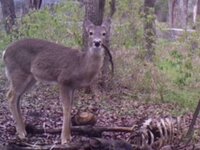DeepseekerADS
Gold Member
- Mar 3, 2013
- 14,880
- 21,733
- Detector(s) used
- CTX, Excal II, EQ800, Fisher 1260X, Tesoro Royal Sabre, Tejon, Garrett ADSIII, Carrot, Stealth 920iX, Keene A52
- Primary Interest:
- Other
https://www.yahoo.com/news/deer-caught-eating-human-remains-064514436.html
Rachael Revesz
The Independent May 9, 2017

Deer caught eating human remains for first time, say scientists
Scientists have discovered the first instance of a deer which eats human remains. The animal was caught mid-feast by a motion-sensitive camera at the Forensic Anthropology Research Facility at Texas State University, a 26-acre area where forensic scientists study how human bodies decompose in the wild.
Scientists also monitor how animals interact with the bodies, but the reaction from the white-tailed deer was an unexpected crunch point.
Deer are mostly herbivores, although they have been known to scavenge small mammals or birds and occasionally eat other meats. As documented in the Journal of Forensic Scientists, the experts explained that the animal captured on camera was the “first known photographic evidence of deer gnawing human remains”.
The deer was scavenging when it came across the decomposing body, which had already been feasted on by vultures. Experts watched as the animal held “the bone in its mouth like a cigar”, on two occasions, in January 2015.
The body had already been outside for 182 days.
Experts estimated the deer was chewing dry bone rather than eating soft tissue.
Deer gnaw on bone of other – non-human – animals to “possibly to obtain minerals absent in their diet” including phosphorous, calcium and sodium during the winter months.
For forensic scientists, the study was not solely to analyse animal behaviour, but also the marks left on the bone by the deer are also useful for future reference.
Rachael Revesz
The Independent May 9, 2017

Deer caught eating human remains for first time, say scientists
Scientists have discovered the first instance of a deer which eats human remains. The animal was caught mid-feast by a motion-sensitive camera at the Forensic Anthropology Research Facility at Texas State University, a 26-acre area where forensic scientists study how human bodies decompose in the wild.
Scientists also monitor how animals interact with the bodies, but the reaction from the white-tailed deer was an unexpected crunch point.
Deer are mostly herbivores, although they have been known to scavenge small mammals or birds and occasionally eat other meats. As documented in the Journal of Forensic Scientists, the experts explained that the animal captured on camera was the “first known photographic evidence of deer gnawing human remains”.
The deer was scavenging when it came across the decomposing body, which had already been feasted on by vultures. Experts watched as the animal held “the bone in its mouth like a cigar”, on two occasions, in January 2015.
The body had already been outside for 182 days.
Experts estimated the deer was chewing dry bone rather than eating soft tissue.
Deer gnaw on bone of other – non-human – animals to “possibly to obtain minerals absent in their diet” including phosphorous, calcium and sodium during the winter months.
For forensic scientists, the study was not solely to analyse animal behaviour, but also the marks left on the bone by the deer are also useful for future reference.



 personally that & Dog food are their only use.
personally that & Dog food are their only use.





